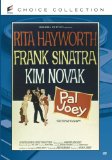| Reviews & Columns |
|
Reviews DVD TV on DVD Blu-ray 4K UHD International DVDs In Theaters Reviews by Studio Video Games Features Collector Series DVDs Easter Egg Database Interviews DVD Talk Radio Feature Articles Columns Anime Talk DVD Savant Horror DVDs The M.O.D. Squad Art House HD Talk Silent DVD
|
DVD Talk Forum |
|
|
| Resources |
|
DVD Price Search Customer Service #'s RCE Info Links |
|
Columns
|
|
|
Pal Joey (Sony Choice Collection)
Blah, lightweight, miscalculated Hollywood version of the famed Broadway musical. Sony Pictures' Choice Collection line of hard-to-find library, foreign, and cult titles has re-released the not-so-hard-to-find-on-DVD Pal Joey, the 1957 musical drama from Columbia Pictures. Based on the Pal Joey short stories of John O'Hara, and the subsequent same-named Broadway musical O'Hara wrote with Richard Rodgers and Lorenz Hart, Pal Joey offers a potentially explosive starring trio (Rita Hayworth, Frank Sinatra, and Kim Novak), along with 14 Rodgers and Hart songs...and only manages to come up with a fairly pedestrian outing that critics today seem to laud for Frank Sinatra standing up there and singing a few tunes--fun if you close your eyes, but not exactly an example of the Hollywood musical as high art. A short interview with Kim Novak is the only bonus here (carried over from a previous DVD release), so no need to double dip...particularly if you already have the superior Twilight Time remixed 5.1 Blu-ray edition from 2012.
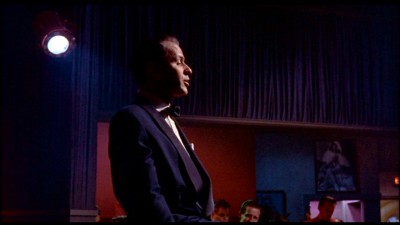
With a cop and a detective firmly attached to both arms, and with not a dime in his pocket, genial, second-rate hustler/womanizer/singer/M.C. Joey Evans (Frank Sinatra) is given the bum's rush outta town, seeing as how he was innocently romancing an underaged girl in his hotel room...and she being the mayor's daughter and all. Arriving in 'Frisco, Joey heads to Pacific Avenue's International Settlement district of nightclubs and bars, looking for eating money from any pick-up gig he can find. Spotting a banner announcing old pal Ned Galvin's (Bobby Sherwood) appearance at the Barbary Coast, Joey gets discouraging words from Ned concerning a job, until Joey hears owner Mike Miggins (Hank Henry) complain that their M.C. has missed an appearance again. Joey, smelling an opportunity, jumps on the stage and lands the job from the suspicious Mike, who knows all about the troubles Joey brings to his employers...usually because of some dame. Rootless Joey has another reason besides starvation to stay at the Barbary: sweet "mouse" Linda English (Kim Novak), an innocent, naive chorus girl with a face and body that won't quit. Soon, heel Joey has most of the chorus girls on the hook, but not wary Linda, nor seen-it-all sharpie, Gladys (Barbara Nichols), but that doesn't stop Joey from relentlessly pursuing Linda. Snagging himself a spot with Ned playing a fancy-schmancy charity auction, Joey foolhardily embarrasses his wealthy hostess, widowed Vera Prentice-Simpson (Rita Hayworth), whom Joey reveals as Vera Vanessa, a former stripper ("Vanessa the Undressa"). Mortified into doing a charity strip for her astonished society friends, the cool, controlled Vera vows revenge, eventually getting Joey almost-fired from his M.C. job. Forced to woo her to get his gig back, Joey slays the lonely Vera, who thinks she's in love and who is willing to back Joey's big dream: his own nightclub, Chez Joey. The only problem? Ruthless Joey may be kinda in love with lovely, young, sweet Linda.
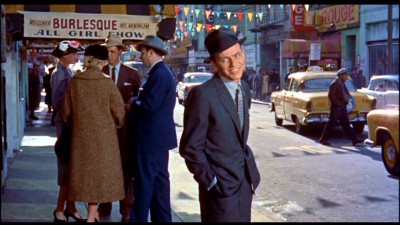
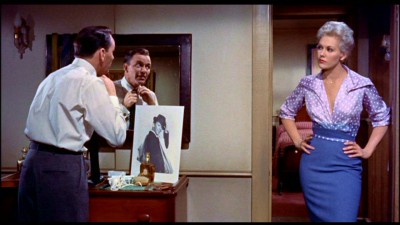
In 1939, New Yorker writer John O'Hara approached the esteemed Broadway team of composer Richard Rodgers and lyricist Lorenz Hart to collaborate on a musical version of O'Hara's gritty, cynical short stories (written in the form of letters from "pal" Joey) about second rate hoofer and first rate heel, Joey Evans. Premiering in 1940, Pal Joey was considered quite controversial with the theater critics and ticket buyers of the day, introducing to the heretofore light, inconsequential musical-comedy format a lowdown tale of a sexual predator who starts off a bum...and remains one at the end, unable to be redeemed by true love. Many critics were turned off by the play's dark tone, and cautious audiences, certainly curious about the forward nature of the lyrics, made it only a moderate hit, running for 10 months (it made a star out of future movie legend, Gene Kelly, though). When those racy songs were finally allowed on radio in the late 1940s (with some lyric changes), a few become standards, such as Bewitched, Bothered, and Bewildered and I Could Write a Book. Rodgers recorded an album of the score in 1950, which proved to be a big enough hit that a far more successful Broadway revival was mounted in 1952. Columbia Picture's mogul, Harry Cohn, had optioned Pal Joey for a movie version starring original lead Gene Kelly way back in 1941, during the play's premiere run, but encountered problems with his censors concerning the sexual dynamics of the play's love triangle (not to mention having to contend with lyrics like, "Horizontally speaking, he's at his very best," and "Vexed again, perplexed again, thank God I can be oversexed again,").
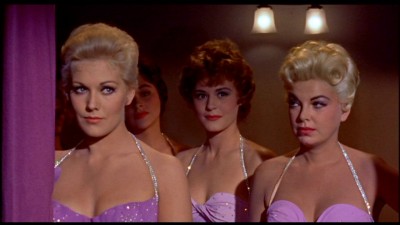
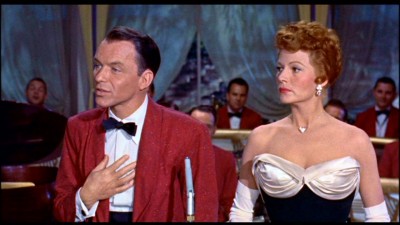
Not letting the property go (particularly since rival studios M-G-M and Fox were making mints off Broadway-inspired musicals), Cohn kept reworking the project's casting; big stars like James Cagney, Cary Grant, Gloria Swanson, Ethel Merman, and Irene Dunne were at one time considered, before the popularity of the 1952 stage revival almost put Billy Wilder at the helm, directing the trio of Marlon Brando, Mae West, and Rita Hayworth. Eventually, Frank Sinatra, riding the crest of his resuscitated "phase two" movie career (thanks to Cohn's 1953 From Here to Eternity), bought into the project with director George Sidney co-producing (Sidney had guided Sinatra to his biggest "phase one" movie career hit, 1945's Anchors Aweigh). To further tantalize the public, Harry Cohn latched onto the irresistible publicity coup of co-starring his two most famous sex symbols: outgoing "love goddess" Rita Hayworth, working off the last commitment of her hated Columbia contract, and incoming Kim Novak, arguably at the very apex of her popularity in 1957...right before the failure of Hitchcock's Vertigo took the first bloom off the rose (red hot Sinatra, when asked why he took second billing inbetween faded star Hayworth and newcomer Kim Novak, famously quipped, "That's a sandwich I don't mind being stuck in the middle of,"). Released on October 25, 1957, Pal Joey proved to be a nice-sized hit for Columbia, pleasing most of the critics and coming in at the end of the year as the tenth most-popular movie at the box office.
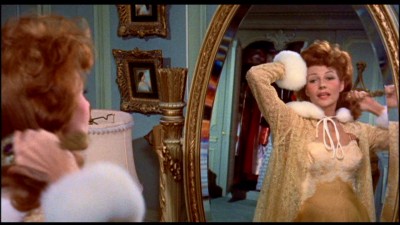
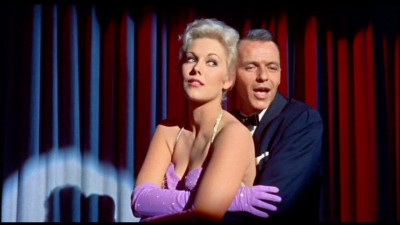
Seen today, however, against the classic works of legendary Hollywood musical directors like Minnelli and Donen (and Kelly), director George Sidney's Pal Joey is a curiously flat outing that features several heart-stopping interludes whenever Frank Sinatra sings those lovely Rodgers and Hart songs, or when we get a flawless close-up of the most intriguing sex symbol of the 1950s, Kim Novak...and that's about it. Many Broadway theatre purists have noted (with almost universal scorn) the changes made, big and small, in Pal Joey's original book and score for this cinematic adaptation. Only ten of the fourteen original songs survive here, with two considered among the play's best, Plant You Now, Dig You Later and You Musn't Kick it Around, reduced to background instrumentals only. Indeed, four of the songs most associated by fans with the movie, My Funny Valentine, I Didn't Know What Time It Was, There's a Small Hotel, and particularly The Lady is a Tramp, are lifted from other Rodgers and Hart projects. A major plot development involving blackmail has been eliminated for the movie, along with the play's tough Chicago setting and important supporting character Melba, the news reporter, while Gladys the chorus girl is severely marginalized. All of that didn't matter a whit to the moviegoers who came to see Pal Joey, probably because the vast majority of them never saw the play on the boards. What does matter, though, is this movie version's biggest switcheroo: turning rat-bastard heel Joey Evans into a genial loser/hound dog, complete with a cute pooch and a totally incongruous 1950s Hollywood happy ending.
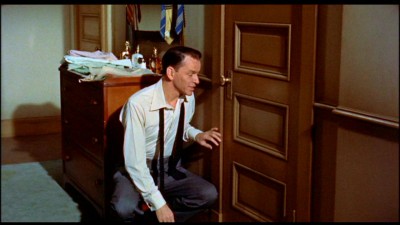
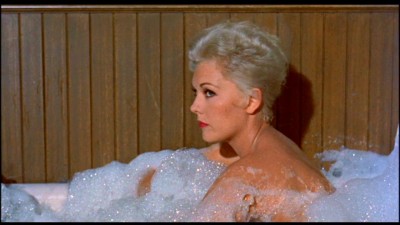
While critics have never found fault with the songs of Pal Joey, the book has been a source of contention ever since 1940. Put simply, not much happens in Pal Joey outside of the songs, so when this movie version further simplifies the love triangle, eliminating the compelling coarser elements of the piece while taking its anti-hero and homogenizing him into hipster banality, well...you've got one shallow-feeling musical on that big, wide screen. Screenwriter Dorothy Kingsley (Angels in the Outfield, Kiss Me Kate, Seven Brides for Seven Brothers, Valley of the Dolls) tries to spackle over the holes with mild sex jokes and slightly risque set-ups ("Oh this kid's got a fine woofer and tweeter!" Joey jokes about a chorus girl who wants him to hear her new hi-fi; "If you were my girl you wouldn't need that," Joey says to a hot water bottle-clutching Linda, before he tries to spot her nude in a bathtub). However, from that opening scene, where naughty boy Joey is comically put on a train for "entertaining" an underaged girl, we're in Sitcom-Land, with Joey, Broadway theatre's first anti-hero of the musical comedy genre, reduced to a cinematic Dagwood, sharing a surprising amount of screen time with "Snuffy," a cute terrier (Sinatra looks pained to be with that hound). Perhaps they could have made Pal Joey a "period" piece, with the storyline taking place during the Depression, rescuing some of the original piece's grit (the old timey chorus line nightclub scene of this Pal Joey was already dying fast by 1957). Or perhaps more location work in Frisco could have given the story some verisimilitude, since so many of the bigger, glossier late 50s dramas (and musicals) were moving outdoors by this point (no wonder the only scenes anyone remembers from this mostly studio-bound movie are the handful of shots of Novak and Sinatra at the International Settlement district). Of course, in the end, that's all window dressing; without a strong, compelling dramatic set-up, you're just left with the performers and their songs--and that's a concert, more than a valid, "true" movie musical.
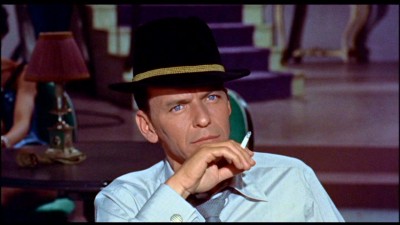
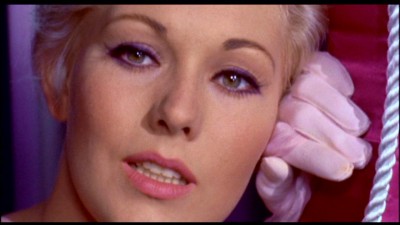
A weakened central Joey Evans isn't exactly helped by a miscast Sinatra. That's right, Sinatra fans (and I'm one of them): Pal Joey is not, as many of you think, the "quintessential" Sinatra performance. True, there's no doubt that Pal Joey best captures on film the iconography of that entity "Sinatra" we cherish the most: the skinny, smiling, cobalt blue-eyed charmer who tosses his trench coat over his shoulder with insouciant ease, as he snaps his fedora brim at just the right angle. These are the images of Sinatra we think of when we picture him in his "classic" period, while his various musical numbers here frame and crystallize that moment in time in which he will always remain, and reign, supreme--regardless of what he did before and after it. Sinatra swinging through The Lady is a Tramp or softly emoting through There's a Small Hotel doesn't get much more perfect in terms of defining the most iconic elements of his mythology. And that's fine...for awhile. Director Sidney does his best to energize these singing scenes, with some smooth camera moves and expressive lighting (courtesy of cinematographer Harold Lipstein), but in the end, they're just cabaret moments, with Sinatra crooning to the camera. It's electrifying at first, but by the end of the movie, we need a lot more than that to buy Pal Joey as a bona fide movie musical (sad to say, the gorgeous Novak and the intriguingly beat-up Hayworth--my god can you believe she's only 39 years old here??--can do little with their dubbed songs. They're beautiful, and they move right, particularly dancer Hayworth, but we can't get past the artificiality of those poorly-matched dubs).
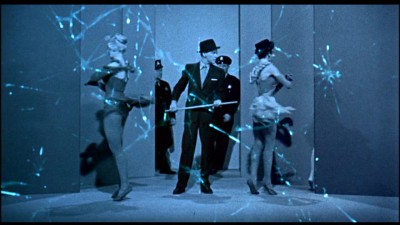
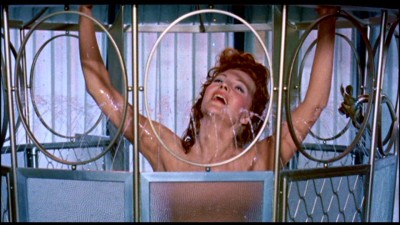
And since Sinatra refuses to engage in anything resembling a "dramatized" musical number, his efforts inbetween the singing have to carry the majority of the movie, and the results are superficial, at best. In Pal Joey, you'll see the Sinatra who could have, as Billy Wilder once lamented, been the actor who made "everyone else look like a bunch of pussies," had he worked at his craft. Most movie fans know, however, that uninterested, restless Sinatra relied on his instincts--and usually the director's first take--to get him through the time-consuming slog of Hollywood moviemaking, with wildly varied results. Here, Sinatra is playing it safe, with his too-easy charm and good humor working against the desperation and calculation and ferocity we're supposed to feel emanating off the bragging cocksman Joey. Instead, Sinatra is too cool for the room, playing at being a loser who can't tell a joke (we don't buy this also-ran act for a second), but never letting his bored eyes tell you anything true beyond the obvious mastery he has with a song (too bad a younger, insincere, brash, cocky Gene Kelly didn't get to do this role on film). Watching him interact with Novak and Hayworth, it's obvious he's relying on the tricks and gimmicks of his personal charm, and not on a crafted performance of any serious effort. As it has been noted (by Novak herself), this attitude even adversely effected the actual production of the movie: the final fantasy dance sequence that could have given Pal Joey some deserved artistic notoriety. When Joey returns to the closed Chez Joey, he imagines an impressionistic dance between himself and his two suitors. What appears on the screen, however, looks like a post-production nightmare of hastily cobbled-together outtakes (keyed for some reason, in black and white), mixed with the central compromised dance sequence. Novak has stated that choreographer Hermes Pan had worked out a fabulous sequence with complicated moves for all three performers--all of which was immediately thrown out by an imperious, obviously irritated Sinatra who walked on the set and started impatiently cutting "business" left and right. Watching him in the few brief seconds where he "dances" with Novak and Hayworth on a ridiculously cramped, plain set, standing with his back to the camera and executing an awkward three-arm spin--you can sense how much he hates doing the number, before it's abruptly, inexplicably cut off. And that's it for Pal Joey's anticipated wrap up. That's Pal Joey's big An American in Paris send-off: perhaps one of the most abbreviated, feeble, pathetic big screen musical finales I've ever seen. SPOILER ALERT By the last shots, when Hayworth isn't giving up on Sinatra but actually helping Novak win him back, as Sinatra and Novak eventually stroll off into studio-bound domestic bliss, I didn't care anymore how they royally screwed up this musical. It wasn't Pal Joey, anyway--it was Pap Joey.
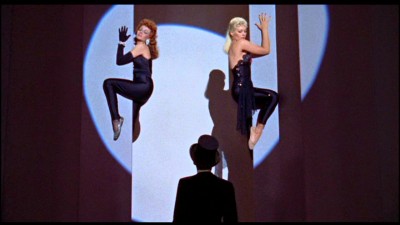
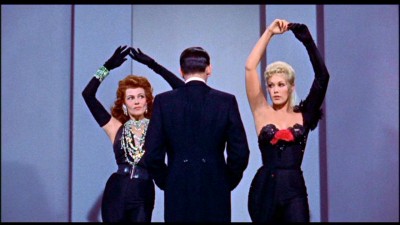
The DVD:
The Video:
Very nice. The anamorphically-enhanced, 1.85:1 widescreen transfer for Pal Joey sported bright, primary colors, subtle values (flesh tones were spot-on), excellent contrast, fine image detail, and little or no screen imperfections. Grain was acceptable.
The Audio:
Owners of the previous Blu-ray release of Pal Joey, with its remixed 5.1 audio track, have one over on us with this Dolby Digital English split mono audio release. Fine, super-clean, and strong...but unexciting. No subtitles or closed-captions.
The Extras:
A nine minute interview with Kim Novak, from 2010, is included here, where she discusses Pal Joey and her life away from Hollywood (this was included in the Kim Novak boxed DVD collection a few years ago). Plain and simple: Novak, for my money, was the premiere sex symbol of her time (please don't even mention the blousy Marilyn Monroe)--gorgeous and erotic and unreachably mysterious--so anything that illuminates her thoughts on her career is most welcome.
Final Thoughts:
Wrong way, pallie. Misconceived from the get-go, director George Sidney's 1957 adaptation of Pal Joey jettisons some good songs, inexplicably inserts some other good Rodgers and Hart songs that don't belong here, and then makes the fatal mistake of turning pal Joey into a real pal with a heart of gold--gosh I never saw that before.... The beautiful Kim Novak and ravaged Rita Hayworth, poor things, are artificially dubbed, robbing them of any authenticity during their musical numbers, while the Sinatra of our collective dreams solidifies his position as the musical interpreter of 20th century romanticism in his electrifying solo numbers. However...movie musicals ain't supposed to be just cabaret; everything else here in Pal Joey is thin, superficial, and unconvincing. Rent it for the songs.
Paul Mavis is an internationally published movie and television historian, a member of the Online Film Critics Society, and the author of The Espionage Filmography.


|
| Popular Reviews |
| Sponsored Links |
|
|
| Sponsored Links |
|
|
| Release List | Reviews | Shop | Newsletter | Forum | DVD Giveaways | Blu-Ray | Advertise |
|
Copyright 2024 DVDTalk.com All Rights Reserved. Legal Info, Privacy Policy, Terms of Use,
Manage Preferences,
Your Privacy Choices | |||||||









